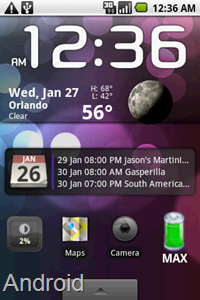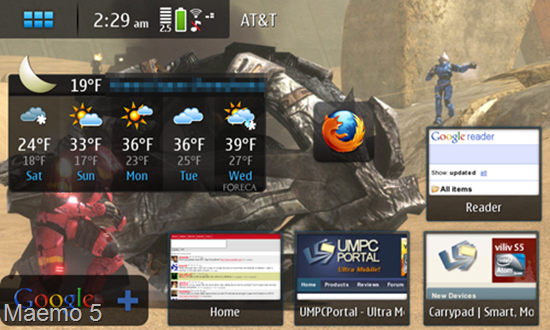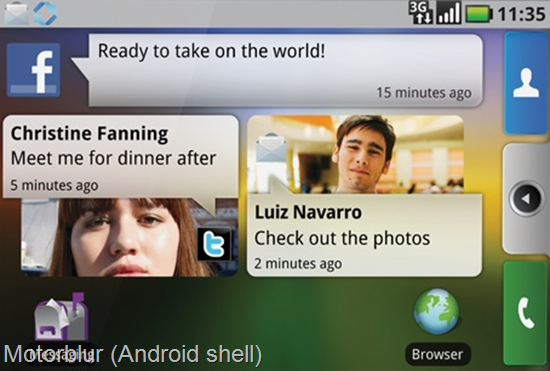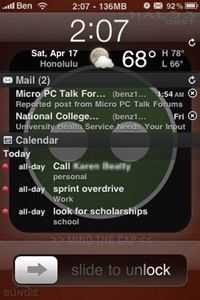Several of the latest mobile operating systems have interfaces that are based on a very bothersome paradigm: the widget-oriented home screen. I really wish the people making the high level design/UI choices could step away from this awful interface concept and think outside the box to some degree (maybe look into what the First Else is doing?). Now, I’m not an interface designer, but I am someone who has used plenty of these devices and at very least, I can tell you why I hate widget-based home screens on mobile operating systems.
First, the players. The big two at the moment are Android and Maemo (there are also several Windows Mobile shells that suport widgets). Additionally, you may have recently seen the WePad [product page] interface demo, which has a widgetized home screen so large that you need a map to navigate it (literally!). All of these essentially use a multi-“desktop inch design which allows the user to customize what widgets are on each desktop as they pan from one to the next.
 A widget is sort of like a tiny application which resides permanently on the home screen. It usually does a simple task, and generally offers little to no further functionality. When you think of the term ‘widget’ what comes to mind, exactly? I’ll tell you what comes to my mind… “shallow inch.
A widget is sort of like a tiny application which resides permanently on the home screen. It usually does a simple task, and generally offers little to no further functionality. When you think of the term ‘widget’ what comes to mind, exactly? I’ll tell you what comes to my mind… “shallow inch.
What exactly do I mean by shallow? Well it’s just that: widgets do something extraordinarily simple. The thing that makes them shallow is that they offer such little functionality that they are practically worthless and become nothing more than a waste of CPU cycles. Generally they do something that could easily be recreated in the status bar. Take, for example, a clock widget. What does it do? It tells the time, perhaps in analog. Is that really useful to anyone? I doubt I’d even waste the space on my screen with an analog clock widget. Is the current time not already displayed in the status bar? How about a widget that shows some recent emails? Generally, the screen is so tight on space that you can only see, perhaps, the last 3 emails that you’ve received, and more often then not, the widget doesn’t sync up with your actual mail application (to mark mail as read, or delete it, etcetera), and then it becomes rather pointless.
Don’t even get me started on the cliché “slideshow inch widget. Is anyone seriously flipping through their multiple desktops to find the slideshow widget so that they can enjoy some random images at 100×100 pixels?
 Even homepage shortcuts, as widgets, can become pointless because of the multi-desktop approach. Should I seriously spend my time swiping through four or five different homes screen desktops to find the shortcut I placed? Wouldn’t it be easier and faster to have the web browser accessible at all times from the push of a button, then just pull up a list of bookmarks?
Even homepage shortcuts, as widgets, can become pointless because of the multi-desktop approach. Should I seriously spend my time swiping through four or five different homes screen desktops to find the shortcut I placed? Wouldn’t it be easier and faster to have the web browser accessible at all times from the push of a button, then just pull up a list of bookmarks?
 Motorola’s “Motoblur inch interface manages to show just one Facebook status update, five words from a tweet, and four words from an email — all on a spacious 480×320 screen. Pathetic.
Motorola’s “Motoblur inch interface manages to show just one Facebook status update, five words from a tweet, and four words from an email — all on a spacious 480×320 screen. Pathetic.
Even if some widgets do link into a deeper application and stay correctly in sync with them, the widget becomes pointless if the user wants to use a different application. Consider an RSS widget that displays a few posts from an RSS feed. Maybe it can launch out to a built-in RSS reader, but then the user is limited to using the built-in application because it is the only one that supports the widget, even if there is a better alternative application.
Mobile applications, which are already confined to small screens and slow (compared to x86) processing power, are already giving users a stripped down experience. What I’m trying to say is that mobile applications are already much like widgets themselves. They provide the essential functionality. Home screen widgets really don’t have a place anywhere on a mobile operating system. They are so simple that, more often then not, they are pointless. They frequently don’t provide any deeper functionality, and when they do, they only link in to one application, which limits the user from using other applications.
Many people laud widgets for providing “at-a-glance inch info, which I don’t have a problem with, but that sort of information is what the status bar is designed for. One glance at a status bar could easily inform you of the time, battery life, new email, missed call, new text, new RSS items, etc., so why are users expected to waste screen space and device resources to have persistently running widgets? With a smart notification system, applications can call attention to themselves and alert that user that something is up (for instance, a new email has a arrived.) The user should be able to launch into the application just by tapping the notification, and do whatever it is that they need to do from the “full inch interface of the application. The widget middle-man is entirely unnecessary.
 Maybe my issue is simply the fact that widgets are so inconsistent. For the most part they are oddly shaped and they all work differently. If someone created a more inclusive widget, that did more than one random function, it might not be so bad. In fact, on the iPhone I use a bit of software called LockInfo (jailbreak only) which replaces the lock screen with what is essentially a glorified notification list, and I greatly prefer it over a bunch of widgets that are spread across multiple desktops. The great part about it is that we aren’t talking about a Facebook widget that shows one status update, we are actually getting a list of notifications that are directly generated from the Facebook application itself. So clicking on an application takes me straight there and I don’t deal with any widget middle-man. This is beneficial because if I want to use an alternative Facebook application, that application can generate its own notifications to go to the lock screen list, rather than being unable to link in to a proprietary Facebook widget. The concept here is a bit different from widgets, but I still have all of the at-a-glance info that I need right from this screen.
Maybe my issue is simply the fact that widgets are so inconsistent. For the most part they are oddly shaped and they all work differently. If someone created a more inclusive widget, that did more than one random function, it might not be so bad. In fact, on the iPhone I use a bit of software called LockInfo (jailbreak only) which replaces the lock screen with what is essentially a glorified notification list, and I greatly prefer it over a bunch of widgets that are spread across multiple desktops. The great part about it is that we aren’t talking about a Facebook widget that shows one status update, we are actually getting a list of notifications that are directly generated from the Facebook application itself. So clicking on an application takes me straight there and I don’t deal with any widget middle-man. This is beneficial because if I want to use an alternative Facebook application, that application can generate its own notifications to go to the lock screen list, rather than being unable to link in to a proprietary Facebook widget. The concept here is a bit different from widgets, but I still have all of the at-a-glance info that I need right from this screen.
Please let me know in comments… am I the only one that hates widgets on mobile operating systems?











I used to have a Nokia N800, and I didn’t use the widgets much. I thought they were a waste of time because they never showed enough information. I usually had to open an app, so what was the point of having the widget?
Actually, I seem to recall that I usually had 4 or 5 apps open anyway, and the apps usually did the same job as the widgets. Really, what was the point of having the widget?
The Palm webOS system is what your describing, it has no widgets on the screen and it has a great notification system.
I wish I had more experience with Palm WebOS to talk more about it. I was thinking about it as I wrote the article. I love the way that they essentially use full applications /as/ widgets, in the way that they can be flipped through easily. But because they are the full applications themselves, they actually have some depth to them.
I fully agree. The only widget I occasionally use on my Magic is the yr.no one to check the day’s weather forecast for my area. Otherwise, as you say, the notification bar is sufficient. My three screens have a single row of my most used apps leaving space for a good view of Bondi Beach.. :)
Mvh
I think the cases you have presented is for the useless widgets, on the flip side as a Maemo user I find the calendar, weather and even music widgets very helpful, they present information I dont need to interact with.
All importantly, let the readers remember you are given choice. The choice to use widgets or apps and the choice to use multiple home screens
I’m not saying that people don’t have a choice, I just feel like interface designers could come up with something that makes a little more sense than various inconsistent widgets.
yes widgets are overall pointless, especially on Android. whats funny is actually the best homescreens ive ever seen are the SPB Shells on old WinMo phones.
the notification system you described is exactly what webOS does, thats why ive always felt they had the best notifications (and multitasking) in the business.
I have had a Samssung s8003 Jet for months now. It is one of the two devices with a widget-based homescreen that I have used. The other was the T-mobile G1.
The only widget I used for any significant period on the Jet was the ActiveSync widget. I found widgets mostly clumsy and useless. It was much more efficient simply going into the phone menu to access my applications.
You make a strong case here. I hadn’t given it much thought before now, but I certainly found those widgets on the Jet mostly redundant. It was mostly the same experience with the G1.
I agree that a lot of widgets are useless, or mostly eye candy.
But it’s just the ability to customize the home screen, so I don’t understand how people could be against it.
If you just want a huge widget with apps shortcuts, or a wheel menu (like First Else), then let it be.
And about the waste of resources, it’s the same as updating the status bar, except a bit more is displayed. It shouldn’t be noticeable.
I use a mix of shortcuts and informations that wouldn’t fit in the status bar (extended notifications and a list of calendar next events/deadlines/TODO).
I’ll agree with what many people have said – widgets are there for people who want to use them. The point of the customizable home screen is that for people who don’t want widgets they don’t have to use them – just use shortcuts.
On my droid, i have a weather/news scroller and a calendar widget. I just want to know the weather quickly when I’m getting out of bed so I know what to dress for. As for the calendar, I’d like to know where I’m supposed to go next without having to open the calendar. And if I do, I can use the calendar widget as a shortcut. On one of my screens, i have a facebook widget that lets me scroll through other people’s status or update my status without needing to open the full program, same with twitter. very useful without having to wait for the time for the entire app to open up.
I must disagree with you. I have the Nokia N900, and the widgets and application shortcuts and even internet shortcuts are brilliant. Why should I have to open the browser first then access a bookmark when I can tap a bookmark from the many desktops (BTW: I have nine desktops full of widgets, bookmarks and links, and they work well for me!
Yes, there are some rubbish widgets such as the slideshow (pointless), even the facebook widget is a waste of time!
What device do you have? (Please don’t tell me the efficient – NOT iPhone?
Yes I’ve got an iPhone and I like the interface design. Applications open fast enough that widgets aren’t necessary, and with jailbreaking you can use LockInfo (pictured in the article) which has everything I want to see at-a-glance.
But after all and even though the presence of widgets you like android; regarding your twitter statement about android and symbian.
Yes, you really need to check out WebOS by Palm. I have a Palm Pre and at first was wondering if I would miss the widget functionality but soon realized that Palm had risen above widgets with it’s intelligent notification process. new email arrives, simple notification show at the bottom of the screen. Works perfectly. There is also a weather application that can show in the notification area, but it is a paid program and I have not tried it yet.
Ever heard of the Andriod App called Slide Screen (pro). It’s just one big screen full of information. It shows calls, mesages, email,calender, stock, twitter and rss fead. Also the slider show the time and weather wifi and 3g.
http://slidescreenhome.com/
It changed how i use my mobile
Widgets are the modern day TSR’s (remember those?). Or something like that. Yes, I hate them, too.
Previously I was tempted by either the Milestone or the N900 (and using much restraint so as not to pull the trigger on either one), but your rant and the Palm comments piqued my curiosity, so I dug out a Youtube video of the Pre presentation. It’s posted by someone going by the name ‘Pocketables’ (never heard of ’em).
This is part five demoing the multitasking / notifications / pop-up, and the way WebOS handles the increasing levels of information/intrusiveness is just plain awesome:
http://www.youtube.com/watch?v=rdfkAeXhfEs
Now I want a Pre :-(
…ha, bummer, that was supposed to be:
<Colbert>never heard of ‘em</Colbert>
(Place here complaint about the lack of an Edit Comment option)
I cannot say I love widgets, but I have the fact that iOS does not have something that shows you what is really going on. I don’t just want to know I got a new email or txt. I want a short summary of it. I want a home screen that gives me who the email or txt is from, plus tasks, etc. This can be a widget, Blackberry style today screen or something else. Slide Screen on Android is close to what I want (no task support currently). In the end, I will take Android over iOS because of customizability.